We decided some time ago that it would be helpful to have an extra hand at the helm. All our cruising to date has seen Robert or me steering Poseidon, and many friends we’ve met since cruising have been surprised that we don’t have an autopilot. Our 12-hour cruise from Yamba to the Gold Coast also confirmed this would be a good decision.
After some research and waiting for the installation, we’re now the proud owners of a Coursemaster CM950 intelligent autopilot system.
Documentation says the CM950 offers the strength and reliability of an extra hand on the helm with an easy-to-operate menu of specific requirements for short-handed round-the-world sailing, tournament fishing, casual cruising, or setting off on a long haul ocean adventure. I think our cruise to Townsville just became a whole lot easier!
This autopilot is manufactured in Australia to perform in one of the harshest marine environments in the world and features the unique rate gyro compass to maximise performance and minimise the effects of roll and pitch, resulting in lower power consumption and enhanced course keeping. Wow, I can’t wait for this!
Changes to Poseidon
Installing the autopilot has involved making some changes to Poseidon. We had hoped to have a shut-off valve installed after the Uniflow 50 valve (since we’re planning to remove this valve in the future), but due to space constraints this didn’t happen.
Changes included installing the following components:
- Two CM950 Control Heads, one in the pilot house and the other on the flybridge.
- A CM941 Junction Box and CM437 Rate Gyro compass in the pilot house (in quite difficult to access spaces).
- An auto pilot helm pump in the lazarette and plumbed into the existing hydraulic lines.
- A new rudder indicator in the lazerette.
- A jog lever on the flybridge.
If you’d like more technical information, please leave a comment below and the ‘brains trust’ will respond!
Sea trial
Today (15 April 2021) we performed our ‘sea trial’ and finalised the setup, which included:
- calibrating the compass by hand steering Poseidon slowly through a full circle, which will reduce deviations caused by magnetic components we have aboard, and
- tuning the steering program to override the original factory settings. This automatically took Poseidon through a series of zig-zag maneuvers to complete the self-tuning.
I’m pleased to say the sea trial was extremely successfully and Charlie (her nickname) performed very well indeed. I think I heard Robert call her “baby” at one stage, and I guess we’re both guilty of a bit of personification! But I did remind him that even though she may be less demanding than me, she can only follow a route, not navigate one!!
While we were out, we also practiced using our ‘jog lever’, which allowed us to take over remotely and steer Poseidon. I was amazed at how quickly/sharply we turned 180° with the press of a finger and we didn’t need to touch the steering wheel. We also practiced exiting the auto pilot mode quickly by using the controls as well as reviewing and changing some of the settings. During this time, I was a bit too quick and accidentally removed the tuning that we’d done before – there’s no “are you sure” prompt when you press the button – but lesson learnt and we just turned around and initiated the tuning procedure again.
To help us learn to use Charlie, we have a system manual which was written by an engineer, so it covers off all the menu settings but is not task-oriented and has no ‘user’ lens! In fact, I’d say the warning about the menu option I stuffed up should have been at the start, not at the bottom of the page after the menu because who reads system manuals anyway! My tech-writer friends will know exactly what I mean.
I just can’t help myself…I’m going to create a quick reference guide to have on hand at the helm.
An important first step
Installing the auto pilot is also an important preparation step in our longer-term plan to upgrade the flybridge and pilot house helm pumps. The helm pumps are what the steering wheels operate to move the rudders. Our helm pumps are 40 years old and probably due for a rest by now! More importantly, our style of helm pump, called a Capillano 250, has a specific part in its system design called the “Uniflow 50” valve (shown in picture in changes to Poseidon). This valve hasn’t been manufactured since the late 1980s and is near impossible to replace. Getting rid of a “single point of failure” (that you can’t buy a spare for) in something as important as your steering is generally a very good thing.
We’re very happy with this new technology, and I think that we’ll appreciate it more because we’ve spent our entire time manually steering to date, so we know what a significant difference to cruising Charlie is going to make.

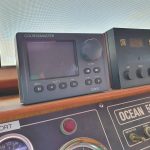
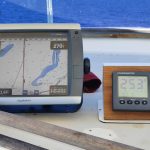
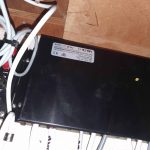

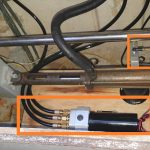
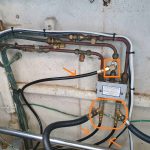
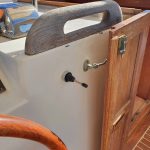
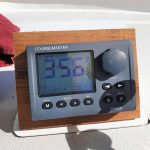
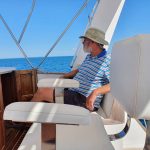

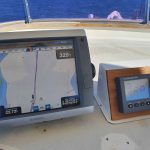


7 Responses
An excellent investment.
Haha same here Pam, I was thinking a user manual QRG was in order and knew you wouldn’t be able to help yourself. You should reach out to the company, you never know they may want to buy your guide! (Copyright pending)
Sounds like a great buy and will really make a difference to you both.
I’m surprised your key point of failure didn’t rate a higher risk rating, to get that mitigation plan in place sooner Lol
Enjoy the new technology.
That sounds like a really good upgrade and should make cruising less stressful – an autopilot. Best wishes, May
Hi Pam, The autohelm will change your life. Your’s is the same model we have on MV Sagitta and also which we had on our previous vessel, a 44ft Sloop. Both have operated very well. I did make one mistake operating the unit on the sloop. I had initiated a 90degree course change in auto and for some reason decided to switch to standby and steer in hand. I selected standby with the rudder over at 20 degrees. As soon as I went to manual the water pressure on the very large spade rudder pushed it hard over. The boat performed a very fast (and scary) 360degree turn before I regained control. This was at 8 knots under motor in a shipping channel. I am now very careful to follow the manufacturer’s instruction to only change from auto to manual or manual to auto with the rudder amidships. Stay safe. Lindsay.
Thanks for your comments and explanation. We’ll certainly keep aware of that feature. Cheers, Pam
Pam I was thinking to myself as you were talking about the user manual you are going to write your own and I was right! Sounds great! Xx Fiona